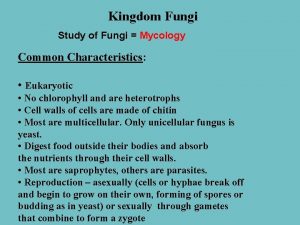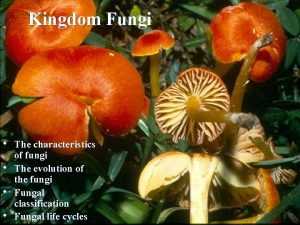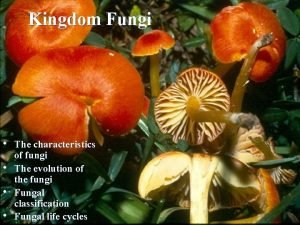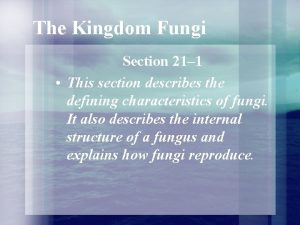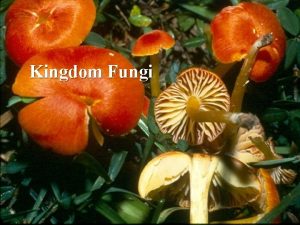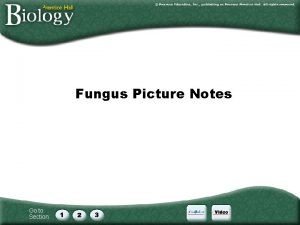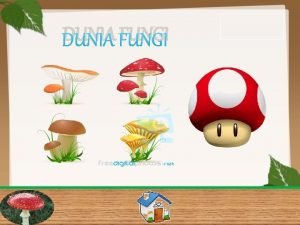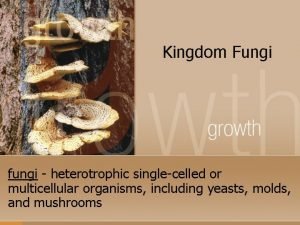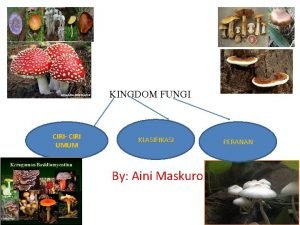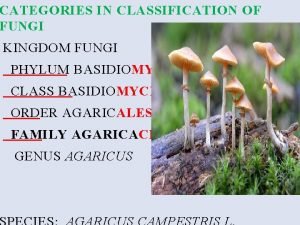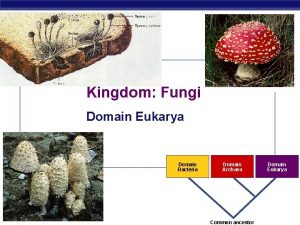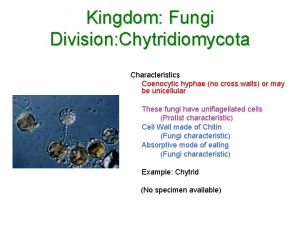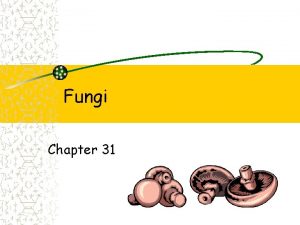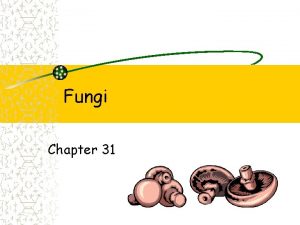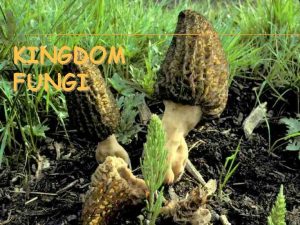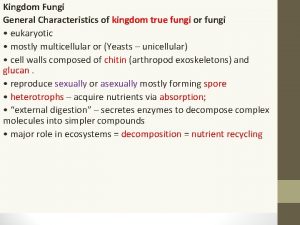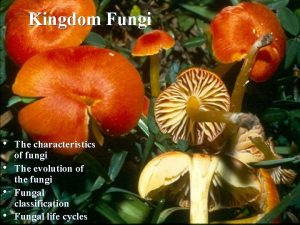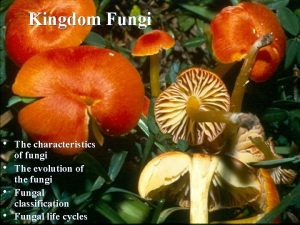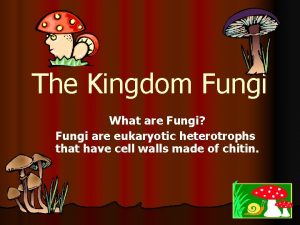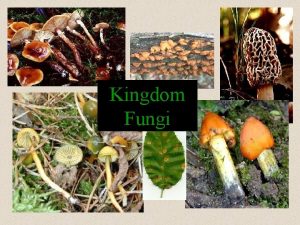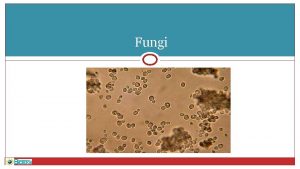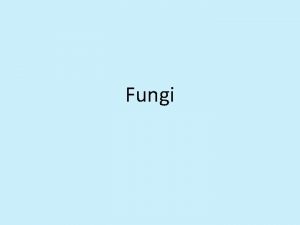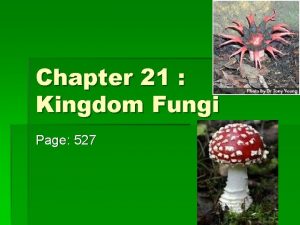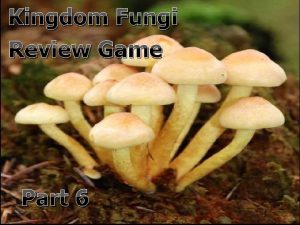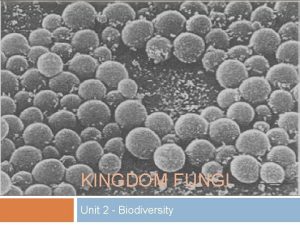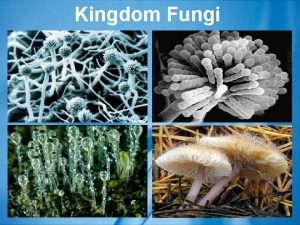Kingdom Fungi The characteristics of fungi The evolution



























- Slides: 27

Kingdom Fungi • • The characteristics of fungi The evolution of the fungi Fungal classification Fungal life cycles

The Characteristics of Fungi • Body form * unicellular * filamentous (tube-like strands called hypha (singular) or hyphae (plural) * mycelium = aggregate of hyphae * sclerotium = hardened mass of mycelium that generally serves as an overwintering stage. * multicellular, such as mycelial cords, rhizomorphs, and fruit bodies (mushrooms)

The Characteristics of Fungi • Heterotrophy - 'other food' * Saprophytes or saprobes - feed on dead tissues or organic waste (decomposers) * Symbionts - mutually beneficial relationship between a fungus and another organism * Parasites - feeding on living tissue of a host. • Parasites that cause disease are called pathogens.

Heterotrophic by Absorption • • Fungi get carbon from organic sources Hyphal tips release enzymes Enzymatic breakdown of substrate Products diffuse back into hyphae Nucleus hangs back and “directs” Product diffuses back into hypha and is used

Fungi as Saprobes and Decomposers

Fungi as Symbionts (Mutualism)

Mycorrhizae • • “Fungus roots” Mutualism between: * Fungus (nutrient & water uptake for plant) * Plant (carbohydrate for fungus) • Several kinds * Zygomycota – hyphae invade root cells * Ascomycota & Basidiomycota – hyphae invade root but don’t penetrate cells • Extremely important ecological role of fungi!

Lichens • “Mutualism” between • * Fungus – structure * Alga or cyanobacterium – provides food Three main types of lichens: * Crustose lichens form flat crusty plates. * Foliose lichens are leafy in appearance, although lobed or branched structures are not true leaves. * Fruticose lichens are even more finely branched and may hang down like beards from branches or grow up from the ground like tiny shrubs.

Fungi as Parasites & Pathogens



Evolution of Fungi • Earliest fossil fungi * Fungal spores * 460 million years old

Opisthokonts • Sister taxon to Fungi: Nucleariids

Evolution of the fungi



asci zygosporangia motile spores basidia Classification & Phylogeny

• • Chytridiomycota – “chytrids” Simple fungi Produce motile spores - zoospores Mostly saprobes and parasites in aquatic habitats Could just as well be Protists Chytridium growing on spores Chytriomyces growing on pine pollen

Zygomycota – “zygote fungi” Rhizopus on strawberries • • • Sexual Reproduction - zygosporangia Asexual reprod. – common (sporangia – bags of asexual spores) Hyphae have no cross walls Grow rapidly Decomposers, pathogens, and some form mycorrhizal associations with plants Rhinocerebral zygomycosis

Sexual zygsporangium with one zygospore Asexual sporangium with spores inside Life cycle of Rhizopus

Ascomycota – “sac fungi” • • • Sexual Reproduction – asci (sing. = ascus) Asex. Reprod. – common Cup fungi, morels, truffles Important plant parasites & saprobes Yeast - Saccharomyces Decomposers, pathogens, and found in most lichens A cluster of asci with spores inside

Sac fungi diversity

Basidiomycota – “club fungi” • • Sexual Reproduction – basidia Asexual reprod – not so common Long-lived dikaryotic mycelia Rusts & smuts –plant parasites Mushrooms, polypores, puffballs, boletes, bird’s nest fungi Enzymes decompose wood, leaves, and other organic materials Decomposers, pathogens, and some form mycorrhizal associations with plants SEM of basidia and spores

Hyphal fusion mycelium and fruiting body are dikaryotic of haploid mycelia haploid mycelium Mushroom Life Cycle N 2 N N+N Meiosis Nuclear fusion in basidium young basidia - the only diploid cells

Bioluminescence in Mycena

Deuteromycota – Form Phylum “Imperfect Fungi” • • Fungi that seldom or never reproduce sexually. Asexual reproduction by vegetative growth and production of asexual spores common.

 Old kingdom middle kingdom new kingdom
Old kingdom middle kingdom new kingdom Old kingdom middle kingdom new kingdom
Old kingdom middle kingdom new kingdom Youtube
Youtube Capital of egypt during the old kingdom
Capital of egypt during the old kingdom Protista mobility
Protista mobility Plantae
Plantae Kingdom protista
Kingdom protista Fungus characteristics
Fungus characteristics General characteristics of cell
General characteristics of cell Mycelium and hyphae
Mycelium and hyphae Characteristics of the eukarya domain
Characteristics of the eukarya domain The odds and ends kingdom
The odds and ends kingdom Nucleariids characteristics
Nucleariids characteristics Section 21-1 the kingdom fungi answer key
Section 21-1 the kingdom fungi answer key Fungal cell characteristics
Fungal cell characteristics Kingdom fungi mind map
Kingdom fungi mind map Peta konsep fungi kelas 10
Peta konsep fungi kelas 10 Kingdom monera protista fungi plantae animalia
Kingdom monera protista fungi plantae animalia Fungi
Fungi Basidiom
Basidiom Fungi heterotrophic
Fungi heterotrophic Is kingdom fungi unicellular or multicellular
Is kingdom fungi unicellular or multicellular Contoh kingdom fungi
Contoh kingdom fungi Phyla of kingdom fungi
Phyla of kingdom fungi Phyla under kingdom fungi
Phyla under kingdom fungi Kapang uniseluler atau multiseluler
Kapang uniseluler atau multiseluler Domain eukarya kingdom fungi
Domain eukarya kingdom fungi What is this structure called?
What is this structure called?








